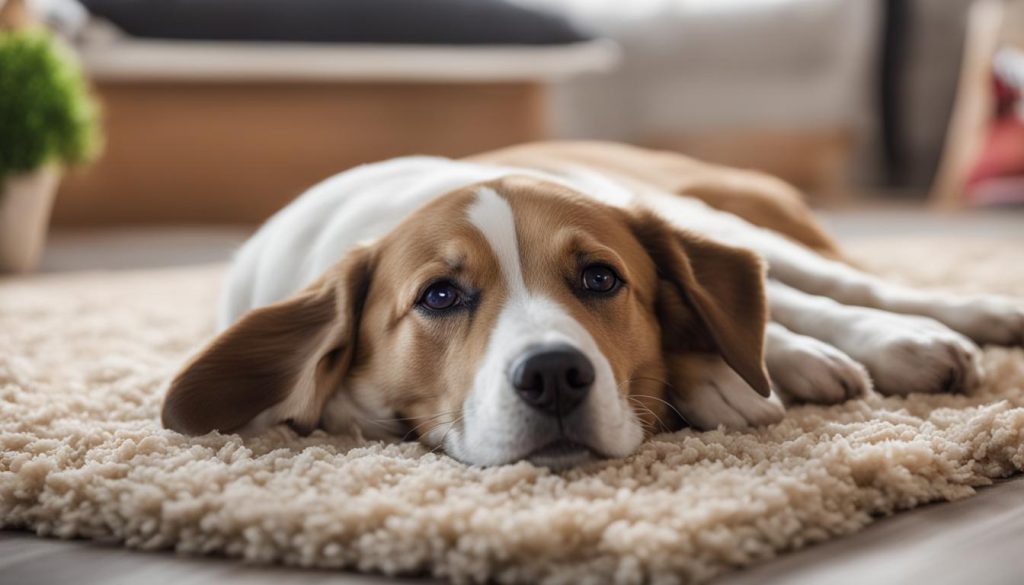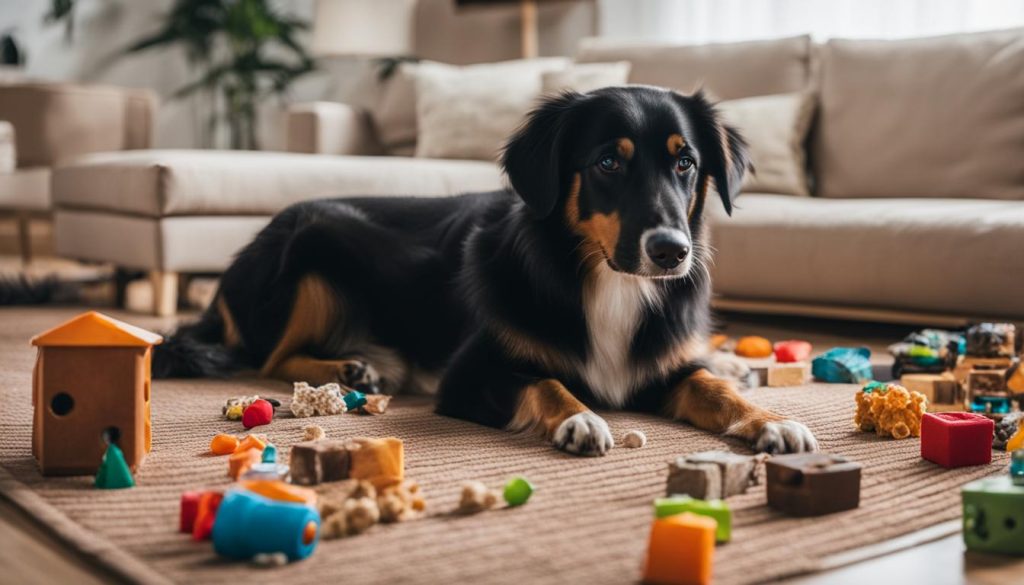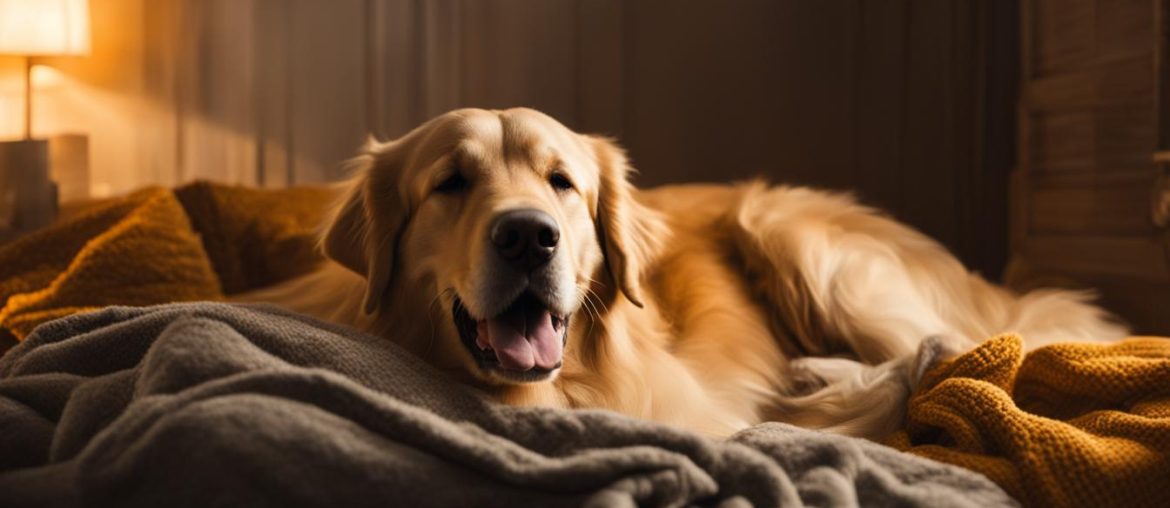Welcome to this guide on teaching your dog to do nothing. In this article, I will share effective dog training techniques that focus on canine behavior modification and teach your dog relaxation skills. By teaching your dog non-action commands and developing calm behavior, you can help them settle and become more patient in various situations.
Many dogs have restless or energetic tendencies, and this exercise can be a valuable tool in managing their behavior. Teaching your dog to do nothing will enable them to relax and learn how to settle down on their own. It can be used in conjunction with other management techniques such as crates, baby gates, and supervised tethering. Dogs naturally spend a significant amount of time doing nothing, and by teaching them this exercise, they can learn to be calm and peaceful.
Key Takeaways:
- Teaching your dog to do nothing helps them settle down, relax, and become calm in different situations.
- You should understand the benefits of teaching dogs to do nothing, including reducing stress and promoting mental well-being.
- The do nothing exercise can be practiced using a step-by-step guide, incorporating positive reinforcement and event markers.
- Reinforcing “nothing behaviors” and applying them in real-life situations can further enhance your dog’s calmness and relaxation.
- Consistency, patience, and regular practice are essential for maintaining and generalizing the do nothing training.
By following these effective dog training methods, you can teach your dog to be calm, patient, and relaxed. This will not only improve their behavior but also strengthen the bond between you and your furry companion. So let’s dive into this training process and help your dog learn the art of doing nothing!
Understanding the Importance of Teaching Your Dog to Do Nothing
Teaching your dog to do nothing is a valuable training technique that goes beyond just teaching basic commands. It is about helping them develop relaxation skills, reducing stress, and promoting overall mental well-being. By teaching your dog to do nothing, you are creating a calm bond with them and providing them with the tools to settle down and relax in various situations.
The importance of teaching dogs to do nothing lies in the benefits it brings to their behavior and emotional state. When dogs learn to be calm and patient, they become less reactive to triggers and stressful situations. This can help reduce unwanted behaviors such as excessive barking, jumping, or aggression. By teaching your dog to do nothing, you are equipping them with the ability to self-soothe and handle various situations with composure.
Relaxation training is also essential for dogs’ overall well-being. Just like humans, dogs need downtime and moments of relaxation to recharge. By teaching your dog to do nothing, you are providing them with the opportunity to unwind and find inner balance. This promotes mental well-being, reduces anxiety, and helps them navigate through their daily lives with a sense of peace and contentment.
In summary, teaching your dog to do nothing is not about inactivity or boredom; it is about teaching them valuable relaxation skills. By understanding the importance of this training technique, you can create a harmonious and balanced relationship with your dog while promoting their overall well-being.
| Benefits of Teaching Your Dog to Do Nothing |
|---|
| Improved behavior |
| Reduced reactivity |
| Increased relaxation |
| Enhanced bond with your dog |

The Do Nothing Exercise – Step-by-Step Guide
To teach your dog to do nothing, you should follow a step-by-step guide that ensures a smooth and effective training process. Here is a detailed outline of the steps involved:
- Prepare a quiet indoor area: Choose a calm and secluded space in your home, such as a bathroom or bedroom. This will help reduce distractions and create a peaceful environment for your dog to learn.
- Use a leash and bedding: Attach a leash to your dog’s collar and place a comfortable blanket or mat at the foot of a chair or seat. The leash will provide you with control and prevent your dog from wandering around during the exercise.
- Practice patience: Sit down on the chair or seat while holding the leash with little room for your dog to move. Ignore any actions or attempts to get your attention from your dog. Instead, wait patiently for them to naturally lie down on the bedding.
- Reward calm behavior: Once your dog lies down on the bedding, lean over and drop a treat between their front feet. This rewards them for the desired calm behavior. Repeat this process, gradually increasing the time between treats to encourage prolonged relaxation.
Try to remain consistent and patient throughout the training process. Use a release word to signal the end of the exercise and reward your dog with some quiet time. With practice, your dog will learn to settle down, relax, and do nothing on their own.

Table: Benefits of the Do Nothing Exercise
| Benefit | Description |
|---|---|
| Promotes relaxation | The do nothing exercise helps your dog learn to relax and settle down in various situations, promoting a sense of calmness. |
| Improves focus | By teaching your dog to do nothing, you can help them develop better focus and attention, enabling them to ignore distractions. |
| Reduces anxiety | Regular practice of the do nothing exercise can help reduce your dog’s anxiety levels, making them more comfortable and confident in different environments. |
| Strengthens bond | Engaging in the do nothing exercise with your dog creates a positive and trust-based relationship, strengthening the bond between you. |
Incorporating Positive Reinforcement in Do Nothing Training
Positive reinforcement is a crucial aspect of dog training, including the do nothing exercise. By using positive reinforcement techniques, such as clicker training or using event markers, you can effectively capture and reinforce desired behaviors in your dog.
Clicker training is a popular method that involves using a distinct sound, usually from a handheld device called a clicker, to mark the exact moment your dog performs the desired behavior. This event marker helps your dog associate the behavior with a positive outcome and encourages them to repeat it.
When incorporating positive reinforcement into the do nothing exercise, you can use the clicker or event marker to capture and reinforce calm behaviors. For example, when your dog lies down and remains settled, you can click or use the event marker and then reward them with a treat. This reinforces the association between calmness and positive rewards, strengthening the desired behavior.
Using positive reinforcement in the do nothing exercise can be highly effective in teaching your dog to be calm and relaxed. By capturing and reinforcing calm behaviors, you can help your dog learn to settle down and stay relaxed in various situations.
| Positive Reinforcement Techniques | Description |
|---|---|
| Clicker Training | Using a distinct sound to mark desired behaviors and reinforce them with rewards. |
| Event Markers | Using verbal cues or other signals to mark desired behaviors and reinforce them with rewards. |
| Reinforcing Calm Behaviors | Using positive reinforcement to reward and encourage calm and relaxed behaviors in your dog. |
Try to be consistent in your use of positive reinforcement and to reward your dog immediately after they perform the desired behavior. This helps them make the connection between the action and the reward, increasing the likelihood of them repeating the behavior in the future. With patience and consistency, you can effectively incorporate positive reinforcement into the do nothing training and help your dog develop calm and relaxed behavior.
Recognizing and Reinforcing “Nothing Behaviors”
When it comes to training our dogs, recognize and reinforce not just the behaviors we want them to perform, but also the moments of inaction or calmness. These “nothing behaviors,” such as silence, glancing, and standing, may seem insignificant, but they can be valuable in promoting relaxation and desired behaviors in our furry friends.
By capturing and rewarding these “nothing behaviors,” we can increase the likelihood that our dogs will resort to them more frequently, potentially replacing less desirable choices. For example, if our dog is lying belly up and staring into space, we can reinforce this behavior by providing treats or verbal praise.
Incorporating positive reinforcement is key to reinforcing “nothing behaviors.” We can use event markers, such as a clicker, to signify the desired behavior and follow it with a reward. By consistently reinforcing calm and quiet moments, we can increase the overall calmness of our dogs and strengthen the association between these behaviors and positive outcomes.

I recommend that you remember that every dog is unique, and what may be a “nothing behavior” for one dog may not be the same for another. Observing our dogs closely and understanding their natural behaviors can help us identify potential “nothing behaviors” to reinforce. By turning these natural behaviors into desired behaviors through positive reinforcement, we can enhance their overall behavior and promote a sense of relaxation and calmness.
Overall, recognizing and reinforcing “nothing behaviors” can be a powerful tool in our dog training toolbox. By capturing and rewarding moments of silence, glancing, and standing, we can increase desired behaviors and promote a calm and peaceful environment for our furry companions.
Reinforcing Nothing Behaviors in Real-Life Situations
Teaching your dog to do nothing is not limited to controlled training sessions; it can also be applied in real-life situations to reinforce calm and relaxed behavior. By consistently rewarding nothing behaviors in various environments, you can help your dog generalize and maintain their relaxation skills.
Reinforcing Calmness Around Distractions
One common challenge is maintaining your dog’s calmness when faced with distractions. To reinforce nothing behaviors around distractions, I would advise that you reward your dog for staying calm and composed in the presence of triggers. For example, if your dog remains calm when encountering another dog, offer praise and a treat. By reinforcing calmness in such scenarios, you can gradually increase their tolerance for distractions and encourage a more relaxed response.
Reinforcing Calm Behavior with Strangers
Meeting new people can be an exciting and sometimes overwhelming experience for dogs. To reinforce calm behavior when introducing your dog to strangers, reward them for doing nothing. When your dog remains relaxed and composed during these encounters, provide treats and positive reinforcement. This helps your dog associate meeting new people with calmness and reduces the likelihood of anxious or reactive behavior.
Reinforcing Calmness During Mealtime
Dogs can become excited and eager during mealtime, often exhibiting behaviors like jumping or barking. By reinforcing calmness during mealtime, you can establish a peaceful routine. When your dog remains settled and composed while you and your family gather around the table, offer a treat as a reward. This reinforces the idea that being calm during mealtime is desirable behavior.
| Real-Life Situation | Reinforcement Technique |
|---|---|
| Calmness around distractions | Reward for staying calm in the presence of triggers |
| Calm behavior with strangers | Reinforce doing nothing during introductions to new people |
| Calmness during mealtime | Treat for remaining settled while the family gathers for a meal |

By reinforcing nothing behaviors in real-life situations, you are equipping your dog with the skills to remain calm and composed in a variety of environments. Try to be consistent in your reinforcement and expectations, using positive reinforcement techniques to reward and strengthen the desired behaviors. With practice and repetition, your dog will develop a strong foundation of relaxation skills that will benefit both of you in everyday situations.
Tips for Reinforcing Nothing Behaviors
When it comes to reinforcing nothing behaviors in your dog, there are a few key tips to keep in mind. Firstly, timing is crucial. You want to reward your dog before they turn to look at you, capturing that moment of calmness. By doing so, you reinforce the desired behavior effectively.
Using prepared treats can also be helpful. Have them in your hand or toss them between your dog’s paws, avoiding any noise that may distract them before rewarding. This ensures that the focus remains on the calmness and relaxation you want to reinforce.
Avoiding distractions is essential during the reinforcement process. Find a quiet environment where your dog can focus solely on the training. This allows them to better understand and associate the rewards with the desired calm behaviors.
If you find it challenging to reinforce nothing behaviors or encounter difficulties during the training process, don’t hesitate to seek professional help from a qualified trainer. They can provide guidance and personalized strategies to address any obstacles you may be facing, ensuring the success of the training.

| Tips for Reinforcing Nothing Behaviors |
|---|
| Time the reinforcement effectively |
| Use prepared treats for smooth rewards |
| Avoid distractions during training sessions |
| Seek professional help if needed |
The Benefits of Teaching Your Dog to Do Nothing
Teaching your dog to do nothing has numerous benefits that can greatly improve their behavior and overall well-being. By practicing relaxation training techniques and reinforcing calm behavior, you can help your dog develop important skills that enhance their quality of life. Some of the key benefits of teaching your dog to do nothing include:
- Improved Behavior: When dogs learn how to relax and settle down on their own, they are more likely to exhibit calm and patient behavior in various situations. This can help reduce unwanted behaviors such as excessive barking, jumping, or destructive chewing.
- Reduced Reactivity: Dogs that have been trained to do nothing are often less reactive to triggers and stressful situations. By teaching your dog to remain calm and relaxed, you can help them cope with potentially anxiety-inducing stimuli.
- Increased Relaxation: The do nothing exercise teaches dogs how to relax and unwind, which is crucial for their mental and physical well-being. By giving them the skills to settle down on their own, you can help create a peaceful and harmonious environment for both you and your dog.
- Enhanced Bond: Teaching your dog to do nothing requires trust, patience, and communication. By working together to achieve a state of relaxation, you can strengthen the bond between you and your dog. This can lead to a greater understanding and connection, resulting in a happier and healthier relationship.
By understanding and implementing the benefits of teaching your dog to do nothing, you can create a positive and rewarding training experience that will have long-lasting effects on your dog’s behavior and well-being.

Table: Benefits of Teaching Your Dog to Do Nothing
| Benefit | Description |
|---|---|
| Improved Behavior | Dogs exhibit calm and patient behavior, reducing unwanted behaviors. |
| Reduced Reactivity | Dogs become less reactive to triggers and stressful situations. |
| Increased Relaxation | Dogs learn to relax and unwind, promoting mental and physical well-being. |
| Enhanced Bond | Training strengthens the bond between dogs and their owners. |
Maintaining and Generalizing the Do Nothing Training
Once you have successfully taught your dog to do nothing and they have mastered the exercise in a controlled environment, you should maintain and generalize their newfound skills. Consistency is key when it comes to reinforcing calm behaviors in your dog, so make sure to practice regularly to solidify their training. Set aside dedicated time each day to work on the do nothing exercise, gradually increasing the difficulty level as your dog becomes more proficient.
One way to challenge your dog is by introducing distractions during the training sessions. Start with mild distractions, such as a low-level noise or a toy nearby, and gradually work your way up to more intense distractions. This will help your dog learn to remain calm and relaxed even in the presence of stimuli that may pique their interest or excitement.
It’s also essential to generalize the calm behaviors your dog has learned to various environments. Practice the do nothing exercise in different locations, such as parks or busy streets, to ensure that your dog can remain calm and settled in any situation. This will help them understand that the do nothing command applies to different settings and not just the controlled environment where they initially learned it.
| Practicing Regularly | Gradually Increasing Difficulty | Generalizing Calm Behaviors | Consistency in Reinforcement and Expectations |
|---|---|---|---|
| Set aside dedicated time each day to practice the do nothing exercise. | Introduce distractions gradually to challenge your dog. | Practice the exercise in different locations to generalize the calm behaviors. | Be consistent in your reinforcement and expectations to maintain the training. |
By maintaining regular practice sessions, gradually increasing the difficulty, generalizing calm behaviors to various environments, and staying consistent in your reinforcement and expectations, you can ensure that your dog continues to excel in the do nothing training. To put it simply, the goal is to create a calm and relaxed companion who can easily settle down in any situation with ease and confidence.
Final Thoughts
In summary, teaching your dog to do nothing is a valuable training technique that can bring numerous benefits. By focusing on relaxation and calmness, you can help your dog settle down and develop patience in various situations. Positive reinforcement plays a crucial role in this process, as it strengthens desired behaviors and promotes a strong bond between you and your dog.
Relaxation training not only improves your dog’s overall behavior but also reduces reactivity and enhances their ability to relax and settle on their own. The consistent practice of reinforcing nothing behaviors helps them generalize these calm behaviors to different environments. By maintaining regular training practices and being consistent in your reinforcement and expectations, you can ensure long-term success in teaching your dog to do nothing.
To put it simply, the key to success lies in patience, consistency, and positive reinforcement. By incorporating these elements into your training routine, you can help your dog develop the valuable skill of doing nothing, leading to a more relaxed and well-behaved furry companion.
FAQ
What is the goal of teaching your dog to do nothing?
The goal is to help them settle down, relax, and learn to be calm in various situations.
How can teaching your dog to do nothing benefit restless or energetic dogs?
This exercise can help them learn how to settle down and relax on their own.
What other management techniques can be used in conjunction with teaching dogs to do nothing?
Crates, baby gates, and supervised tethering can be used alongside this training.
Why is teaching your dog to do nothing important?
It helps them learn to relax and settle down on their own, promoting their overall mental well-being.
How can teaching your dog to do nothing improve their behavior?
It teaches them to be calm, patient, and relaxed, making them less reactive to triggers and stressful situations.
What is positive reinforcement and how can it be incorporated into the do nothing exercise?
Positive reinforcement is using rewards to reinforce desired behaviors. It can be incorporated by rewarding calm behaviors during the exercise.
How can “nothing behaviors” in dogs be reinforced?
By capturing and rewarding behaviors such as standing, glancing, or lying belly up and staring into space.
How can you reinforce nothing behaviors in real-life situations?
You can reinforce calmness around distractions, with strangers, and during mealtime by rewarding your dog for doing nothing.
What tips can help with reinforcing nothing behaviors?
Timing of reinforcement, using prepared treats, avoiding distractions, and seeking professional help if needed.
What are the benefits of teaching your dog to do nothing?
Improved behavior, reduced reactivity, increased relaxation, and a strengthened bond with your dog.
How can you maintain and generalize the do nothing training?
Practice regularly, gradually increase difficulty, generalize calm behaviors to various environments, and maintain consistency in reinforcement and expectations.






